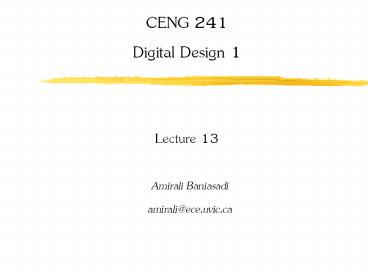CENG 241 Digital Design 1 Lecture 13 PowerPoint PPT Presentation
Title: CENG 241 Digital Design 1 Lecture 13
1
CENG 241Digital Design 1Lecture 13
- Amirali Baniasadi
- amirali_at_ece.uvic.ca
2
Other Counters Ring Counter
A ring counter is a counter with ONLY 1 flip-flop
set to 1 at any particular time, all other are
cleared.
3
Other Counters Johnson Counter
A 4 flip-flop ring counter that produces 8 states
(not 4).
4
Memory
- Memory unit
- Stores binary information
- A collection of cells
- Two types of memory
- RAM-Random Access Memory
- ROM-Read Only Memory
- RAM Can read and write
- ROMProgrammable Logic Device (PLD)
5
Programmable Logic Device PLD
- Programming hardware procedure to insert bits
into the configuration. - Different PLDs ROM, Program Logic Array (PLA),
Program Array Logic (PAL), Field Programmable
Field Array (FPGA) - PLD may include hundreds of millions of gates
- To show logic we use concise forms
6
Conventional and Concise Symbols
7
Random Access Memory
The time to transfer data in and out the device
is the same
Information stored in group of bits called words.
Each word is assigned an address.
8
Memory Content Example
1024 memory locations 10 bit address
16 bit data
9
Write and Read Operation
- Write Operation
- 1.Apply the binary address to address lines
- 2.Apply the data to the data lines
- 3.Activate the write input
- Read Operation
- 1.Apply the binary address to the address lines
- 2.Activate the read input
10
Memory Decoding
- Memory Decoding Select the memory word specified
by the address - A memory with m words and n bits per word
consists of m x n storage cells and decoding
logic.
11
Memory Cell
12
4 x 4 RAM
13
Coincident Decoding
- Regular decoding is costly
- A decoder with k inputs and 2K outputs requires
2K AND gates with k inputs per gate. - Total number of gates can be reduced by using
two-dimensional decoding - Basic idea arrange memory cells in a ( as close
as possible to) square configuration. - Use two k/2 input decoders instead of one k input
decoder
14
Two-Dimensional Decoding
Instead of using a single 10 x 1024 decoder we
use two 5x32 decoders.
One decoder picks the row, one the column
15
Two-Dimensional Decoding
Needs 64 5-input AND gates instead of
1024 10-input gates.
Address is divided to two equal parts
What if impossible?
16
Address Multiplexing
- Two types of RAM Static RAM (SRAM) Dynamic RAM
(DRAM) - DRAM needs refreshing but has less number of
transistors - DRAMs have four times the density of SRAMs.
- DRAM is almost 4 times cheaper than SRAM.
- DRAM consumes less power.
- Since DRAM are large in size, they are arranged
in two-dimensional arrays.
17
Address Multiplexing
Note that the same line is used for both row and
column.
Therefore address decoding is done in two steps
18
Read-Only Memory
19
32x8 ROM
Each OR gate has 32 inputs
20
ROM Programming
1s are connected ( x) 0s are not.
At 00000, 10110110 is stored. At 11111,
00110011 is stored.
21
Combinational Circuit Implementation
- We can assume that each output bit can be
considered as a Boolean function. - Combinational circuits can be used.
- Example A7(I4,I3,I2,I1,I0) S(0,2,3,29)
22
Example 7-1
Design a circuit using a ROM that accepts a 3-bit
number and generates the square.
23
Combinational PLDs
- A combinational PLD consists of gates divided
into AND array and OR array gates to provide an
AND-OR sum of product implementation. - Program Logic Array (PAL) Most flexible PLD,
both AND and OR arrays are programmable
24
Programmable Logic Array
- Two differences of PLA with PROM
- 1-PLA does not provide full decoding
- 2-PLA does not generate all minterms
25
Program Logic Array (PLA)
Each input goes through a buffer and an inverter
F1 ABACABC
F2 (ACBC)
26
PLA Programming Table
inputs
Output
T C
Product Term A B C
F1 F2 AB 1
1 0 - 1 - AC
2 1 - 1
1 1 BC 3
- 1 1 - 1
ABC 4 0 1 0
1 -
27
Example 7-2
- Implement the following two Boolean functions
with a PLA - F1(A,B,C) S (0,1,2,4)
- F2(A,B,C) S (0,5,6,7)
28
Example 7-2
29
Program Array Logic (PAL)
PAL PLD with a fixed OR array and programmable
AND array.
30
Fuse Map for PAL
w(A,B,C,D) S (2,12,13) x (A,B,C,D) S
(7,8,9,10,11,12,13,14,15) y (A,B,C,D) S
(0,2,3,4,5,6,7,8,10,11,15) z (A,B,C,D) S
(1,2,8,12,13) wABCABCD x ABCD y
ABCDBD z ABCABCDACDABCD
wACDABCD
Has four inputs, by using w, we reduce inputs to
3.
31
Fuse Map for PAL
wABCABCD x ABCD y
ABCDBD z ABCABCDACDABCD
wACDABCD
32
2003 final exam
33
Summary
- Memory Programmable Logic

